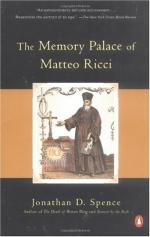
|
| Name: _________________________ | Period: ___________________ |
This test consists of 5 multiple choice questions, 5 short answer questions, and 10 short essay questions.
Multiple Choice Questions
1. Who criticized the use of "monstrous" images for causing "madness and frenzy instead of profound and sure memory"?
(a) Ludolfus of Saxony.
(b) Ignatius Loyola.
(c) Thomas Aquinas.
(d) Cornelius Agrippa.
2. During the trip in 1578, what did the ships on which Ricci was riding pick up in Mozambique?
(a) Crates of Bibles for the missions.
(b) Several hundred slaves.
(c) Nuns and orphans bound for Portugal.
(d) Dysentery and malaria.
3. On this trip in 1578, what skills did Ricci develop?
(a) Mapmaking and navigating through bad weather.
(b) Engineering and sailing.
(c) Foreign languages and painting.
(d) Astronomy and alchemy.
4. In what year did Ricci join the Jesuits?
(a) 1552.
(b) 1583.
(c) 1571.
(d) 1610.
5. According to "Chapter Three, the First Picture: The Apostle in the Waves", to whom did Ricci give the first picture?
(a) Kwok Sing.
(b) Cheng Dayue.
(c) Dayue Cheng.
(d) Kim Suk.
Short Answer Questions
1. According to Ricci, which one of these is NOT a way in which memory palaces can be built?
2. How many Christians were in the Japanese army during the 16th century?
3. According to "Chapter One: Building the Palace", how did Ricci believe that humans could remember anything?
4. According to "Chapter Two, The First Image: The Warriors", what does the Chinese idiograph "wu" symbolize?
5. In what other way were mnemonic devices used during the 16th century?
Short Essay Questions
1. Describe the first picture, "The Apostle in the Waves" that Ricci used to instruct the Chinese.
2. What did Ricci need the new image associated with the first picture "The Apostle in the Waves" to represent?
3. Describe the map that Ricci has printed in 1602.
4. What had the Japanese done to make Ricci's life difficult?
5. What experiences led to Ricci's skill in drawing maps?
6. According to "Chapter One: Building the Palace", what was the size of the Memory Palace that Matteo Ricci used to teach the Chinese people?
7. About what did Ricci's Chinese Christian converts complain?
8. What is a "huihui"?
9. What were conditions in Ricci's home city of Macerata when he was a young boy?
10. What did Ignatius Loyola, founder of the Jesuits, think of mnemonic devices?
|
This section contains 844 words (approx. 3 pages at 300 words per page) |

|




